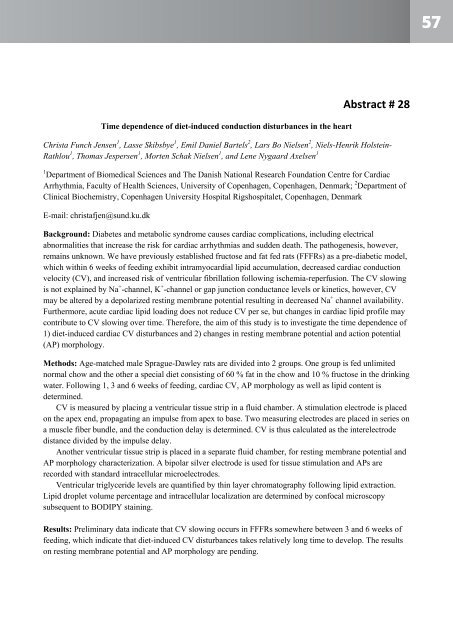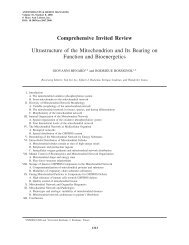MiPsummer Programme pdf - Mitochondrial Physiology Society
MiPsummer Programme pdf - Mitochondrial Physiology Society
MiPsummer Programme pdf - Mitochondrial Physiology Society
Create successful ePaper yourself
Turn your PDF publications into a flip-book with our unique Google optimized e-Paper software.
57<br />
Time dependence of diet-induced conduction disturbances in the heart<br />
Abstract # 28<br />
Christa Funch Jensen 1 , Lasse Skibsbye 1 , Emil Daniel Bartels 2 , Lars Bo Nielsen 2 , Niels-Henrik Holstein-<br />
Rathlou 1 , Thomas Jespersen 1 , Morten Schak Nielsen 1 , and Lene Nygaard Axelsen 1<br />
1 Department of Biomedical Sciences and The Danish National Research Foundation Centre for Cardiac<br />
Arrhythmia, Faculty of Health Sciences, University of Copenhagen, Copenhagen, Denmark; 2 Department of<br />
Clinical Biochemistry, Copenhagen University Hospital Rigshospitalet, Copenhagen, Denmark<br />
E-mail: christafjen@sund.ku.dk<br />
Background: Diabetes and metabolic syndrome causes cardiac complications, including electrical<br />
abnormalities that increase the risk for cardiac arrhythmias and sudden death. The pathogenesis, however,<br />
remains unknown. We have previously established fructose and fat fed rats (FFFRs) as a pre-diabetic model,<br />
which within 6 weeks of feeding exhibit intramyocardial lipid accumulation, decreased cardiac conduction<br />
velocity (CV), and increased risk of ventricular fibrillation following ischemia-reperfusion. The CV slowing<br />
is not explained by Na + -channel, K + -channel or gap junction conductance levels or kinetics, however, CV<br />
may be altered by a depolarized resting membrane potential resulting in decreased Na + channel availability.<br />
Furthermore, acute cardiac lipid loading does not reduce CV per se, but changes in cardiac lipid profile may<br />
contribute to CV slowing over time. Therefore, the aim of this study is to investigate the time dependence of<br />
1) diet-induced cardiac CV disturbances and 2) changes in resting membrane potential and action potential<br />
(AP) morphology.<br />
Methods: Age-matched male Sprague-Dawley rats are divided into 2 groups. One group is fed unlimited<br />
normal chow and the other a special diet consisting of 60 % fat in the chow and 10 % fructose in the drinking<br />
water. Following 1, 3 and 6 weeks of feeding, cardiac CV, AP morphology as well as lipid content is<br />
determined.<br />
CV is measured by placing a ventricular tissue strip in a fluid chamber. A stimulation electrode is placed<br />
on the apex end, propagating an impulse from apex to base. Two measuring electrodes are placed in series on<br />
a muscle fiber bundle, and the conduction delay is determined. CV is thus calculated as the interelectrode<br />
distance divided by the impulse delay.<br />
Another ventricular tissue strip is placed in a separate fluid chamber, for resting membrane potential and<br />
AP morphology characterization. A bipolar silver electrode is used for tissue stimulation and APs are<br />
recorded with standard intracellular microelectrodes.<br />
Ventricular triglyceride levels are quantified by thin layer chromatography following lipid extraction.<br />
Lipid droplet volume percentage and intracellular localization are determined by confocal microscopy<br />
subsequent to BODIPY staining.<br />
Results: Preliminary data indicate that CV slowing occurs in FFFRs somewhere between 3 and 6 weeks of<br />
feeding, which indicate that diet-induced CV disturbances takes relatively long time to develop. The results<br />
on resting membrane potential and AP morphology are pending.



